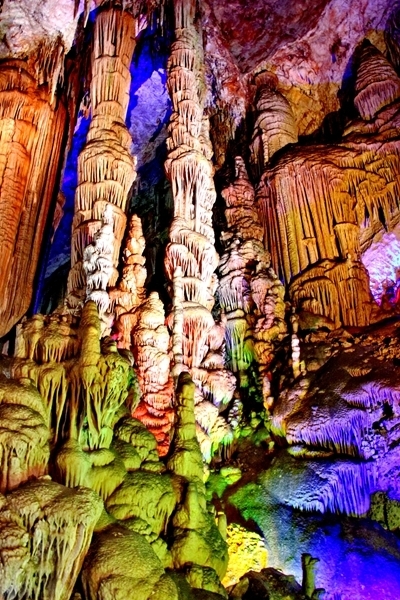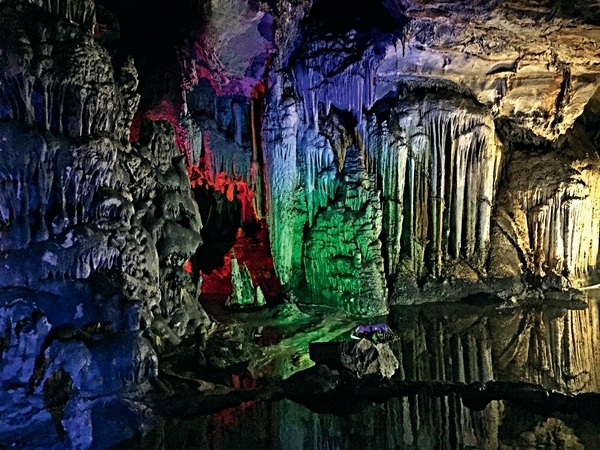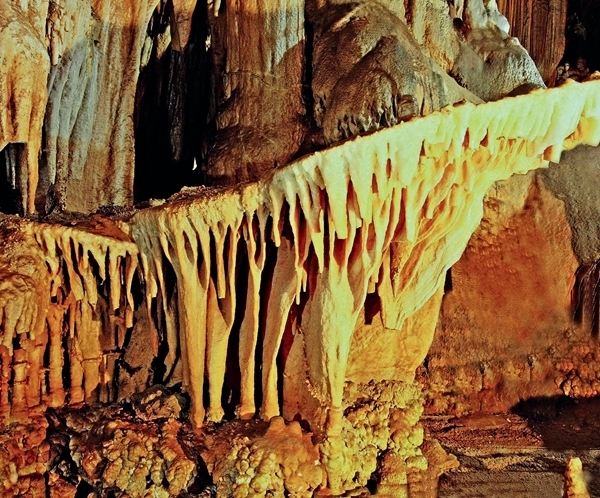Beijing's underground wonder world of eternal spring
 0 Comment(s)
0 Comment(s) Print
Print E-mail China Today, May 8, 2017
E-mail China Today, May 8, 2017
If you are keen on spelaeology (the study of caves and other karst features), you will doubtless have heard of a cave in southwest Beijing known as Shihuadong. The so-called “Subterranean Pearl of Beijing” is well worth a visit even for those of us who are unfamiliar with this pursuit.
Shihuadong (Stone Flower Cave) is located in Nancheying Village in the magmatic national geological park of Fangshan District, about 50 km from downtown Beijing. Discovered in the year 1446, it is a seven-story water-eroded cave with a drop of 130 meters. At present, only the topmost four layers are open to the public, but they offer a 2,500-meter, almost two-hour touring route.

The cave, originally named Qianzhen, was discovered during the Ming Dynasty (1368-1644) by a Chinese monk called Yuan Guang. It covers an area of about 1.8 hectares, and contains 12 huge “halls” interconnected through numerous narrow passages with 16 “chambers” and 71 branch caves. The complex includes around 18 scenic areas and more than 120 different panoramas to enjoy from the vantage point of its 16 chambers.
The first chamber contains three large Buddha statues dating back to 1456, which means they were erected just 10 years after the cave was discovered. It was hence renamed Shifodong – Stone Buddha Cave – before being again renamed to reflect the abundant stone “flowers” on the cave floors.

The natural landscape inside Shihuadong is breathtaking. You lose track of how many stalactites and stalagmites there are that have been formed by mineral deposits (primarily calcium carbonate) in dripping water over the eons. (In case you get confused, the stalactites are the ones that hang from the ceiling and the stalagmites are the ones that grow up from the floor.)
In the No.1 Hall a huge stalactite with a three-meter diameter hangs 18 meters from the ceiling. It is reputed to be China’s biggest. The hall is also abundant in stone curtains, waterfalls, troughs, terraces, pearls, grapes, and chrysanthemums, as well as curling stones (helictites), masonry dams, crystal flowers, and fur stones.
The caves have been thoughtfully adapted for public viewing. To compensate for the absence of gentle slopes, walkways and staircases have been installed. Although only four of the seven stories are open to the public at present, a staircase to the cavern’s lower levels is doubtless planned.

The cave’s management has truly excelled itself in conveying a sense of wonder to visitors through its use of hyperbole. The brochure describes its interior as “... a fairyland on earth. You will be amazed at nature’s creativity.” It has also given descriptive names, such as “Frolicking Carps,” “Mirage Fairy Island,” “Chess Ground,” “Crowing Rooster,” “Heavenly Abode,” “Dragon Coiling Jade Column,” “Bamboo Fenced Thatched House,” “Willow Shadow,” “Spring Bamboo Shoots,” “Blooming Stalagmites,” and “Greeting Turtle” to each of the cave’s “landscapes.”
The “Immortal Appreciating Cascades” are among the most impressive formations. Reputedly the biggest stalactites in China, to do them full justice the management has installed various colored lights to bring out their features during the continuing descent to the bowels of the earth.
“Everywhere is full of the sound of water dripping ‘Di-Di-Da,’ which is composed into delightful music,” the brochure says. Some of the formations bring to mind the organ pipes which so frequently featured in gothic horror movies of the 1950s and 1960s.
As the temperature within the entire cave network is a constant spring-like 13 degrees Celsius, it is an ideal storage place for wine to mature. This advantage has been exploited by the Moutai marketing department. A special edition of the company’s famous baijiu (a traditional Chinese spirit) is housed in Shihuadong, and it is its sole retail outlet for visitors seeking a suitable souvenir of their subterranean tour.
Our underground journey is almost over. To allay any worries that what goes down must also toil its way back up I would add that the cave entrance is through a concrete tunnel that leads to the first chamber, but its point of exit is from the second level. So there is no arduous four-story climb back to daylight and terra firma.
Brian Salter is a broadcaster and journalist who has been working in China for the past five years.






Go to Forum >>0 Comment(s)